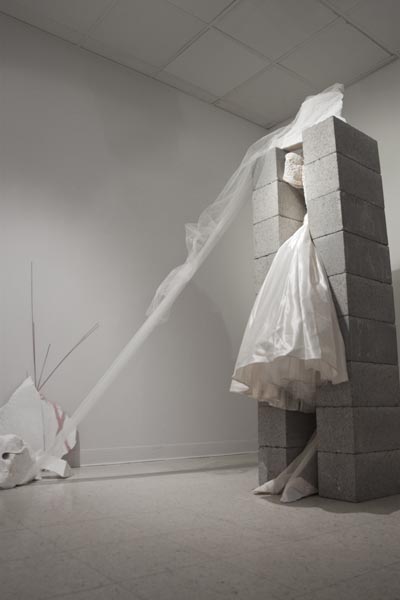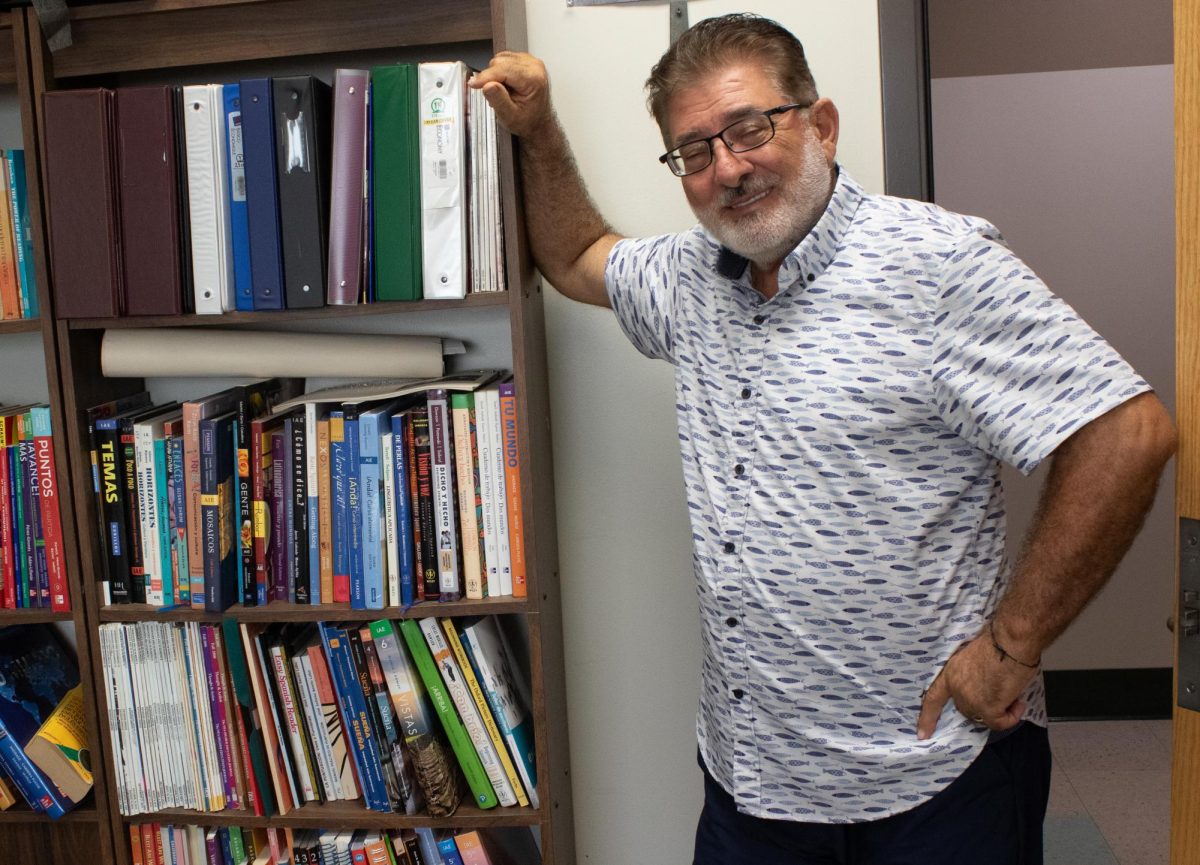Marble from Michelangelo quarry in exhibit at Sac State

The Last Wedding:A wedding dress stands between two concrete block pillars in the Else Gallery in Kadema Hall as part of Marianne Ryan?s ?The Last Wedding, Part 1: In Progress.? Bottom left: Ryan used balanced stones in her exhibit.:Chris Chang – State Hornet
April 20, 2010
Marianne Ryan, a Woodland-based artist whose work is displayed in the Witt Gallery at Sacramento State, uses the same marble stone that Michelangelo used in his popular works in the late 15th and early 16th centuries.
In her exhibit, “The Last Wedding Part 1: In Progress,” Ryan uses marble stone to portray a wedding precession that she envisions to be the last wedding on Earth.
“This exhibit is addressing the curiosity in my mind of whom and what people might attend or participate in what will be the last wedding,” Ryan said. “I suspect it will happen one day.”
Ryan abstractly portrayed the idea of “The Last Wedding” by strategically placing stones in different groupings alongside beautiful draperies. This rock groupings follow a somewhat of a linear fashion, like that of a wedding procession, that follows her main piece: a beaded wedding dress.
The dress is framed by two concrete-block pillars that act as a support system for a larger white slab of marble that weighs more than 50 pounds, Ryan said.
The marble, she said, is directly from the Michelangelo quarry in Carrara, Italy. She said Michelangelo got his marble from this quarry when he was creating his sculptural work during the Renaissance.
“There are several Roman structures created from this quarry where Ryan got her marble,” said Michele Taylor-Hamilton, grad student and co-curator of the exhibit. “The most important, of course, would be the Pantheon.”
After seeing this magnificent marble, Ryan said she was overwhelmed with desire.
“I just knew I had to have it,” she said.
Fortunately, Ryan was able to meet the owner of this well-known Italian quarry and was promised she could have all of the marble she wanted.”They proceeded to slice pieces of marble off like bread,” Ryan said. “Pieces that I myself could handle, pick up and carry.”
Ryan then brought the marble home by suitcase, and began working on creating her vision.
“I just wanted to show the marble because, to me, this is the most beautiful thing I have seen in the world,” Ryan said. “I became very dedicated to working with this magnificent stone.”
When thinking of ways she could showcase the stone, Ryan said, she came up with the idea of a wedding theme because of the pure-white coloring.
“I thought I could use this material, the purest white in the world, to represent the idea that it is appropriate to wear white at a wedding,” Ryan said.
To portray the followers of the wedding, Ryan created groups of stone with their own specific items that resembled offerings guests might offer the bride and groom of the last wedding.
“Each group is delivering what they feel is the most important thing that should be included in the wedding,” Ryan said. “In this case, it would be the items for the wedding dress or items that the bride needs.”
Items offered to the bride include buttons and ribbons. These items, Ryan said, are an offering for the bride, since she might need a fastener for her wedding gown.
She used old American threads dating from around 1905, Irish lace and even satin fabrics from France.
“The items I have shown are the intended to be the finest of what you can have,” Ryan said. “When it comes to the last wedding on Earth, it should be only the most elegant items.”
One interesting factor about all of the items used is the lack of adhesives used when places the items together, said Dana Iske, senior art history major and Ryan’s student assistant. She said not using glues or other materials to hold the stone together was very nerve-wracking.
“I worked with the artist to help set it up and it was pretty difficult because a lot of it was like a balancing act,” Iske said. “It was all about placement and figuring out where all of the rocks belonged in the room.”
At the end of the wedding procession is the main piece – a wedding dress nestled between two concrete block pillars with a large marble stone on top.
Taylor-Hamilton said she felt as if the pillars appear to be restricting the dress, or in this case, the bride.
“I am looking at it as this individual being squeezed into this idea of being married,” Taylor-Hamilton said. “It depends on the viewer, but I feel uncomfortable looking at how the concrete blocks restrict the dress.”
Michael Montgomery, senior graphic design major, also felt as if this main piece portrayed an uncomfortable situation where the bride is being trapped.
“It’s interesting to see the progression of the rocks – they seem to get heavier and heavier until you get to the wedding dress and are stopped by all of the weight,” Montgomery said. “The concrete pillars remind me of being trapped in marriage.”
Unfortunately, this is not what Ryan was trying to portray with this main piece. She said the concrete pillars surrounding the dress are for support, rather than restriction.
“The dress is about being held secure until it is needed for the last wedding,” Ryan said.
After all her hard work, Ryan felt the need to share the exhibit with Sac State.
“People need to see something this beautiful exists in the world, exactly the way it comes out of the ground,” she said.
Erin Rogers can be reached at [email protected]























































































































